Home » Your Local Area » Goulburn Shire
Local Profile for Goulburn Mulwaree Council
Goulburn Mulwaree Local Government Area
Hazard Exposure Summary
Climate Change Data Summary
Risk Exposure Summary
Reference
Goulburn Mulwaree Council is a local government area (LGA) located in the Southern Tablelands region of New South Wales (NSW). The LGA covers an area of 3,223km² with an elevation of 500 – 700m¹.
Goulburn Mulwaree LGA is the traditional homelands of various Aboriginal groups including the Gundungurra and Ngunnawal people.
Goulburn Mulwaree LGA is strategically situated on the Hume/ Federal Highways, approximately 1 hour from Greater Sydney and 1 hour from Canberra within the Southern Tablelands of NSW. It is also within close proximity to the Southern Highlands railway lines.
Socio-Demographic Profile
In 2024, the estimated residential population for Goulburn Mulwaree was 33,112 persons²
In 2021, based on the Australian Bureau of Statistics (ABS) 2021 census data, Goulburn Mulwaree consisted of:
- Population – 32,150;
- Aboriginal and Torres Strait Islander population – 5.1% (1,620 persons); ³
- No of properties/dwellings – 14,739;
- Persons aged under 5 – 5.7% (1,829 persons);
- Persons aged over 65 – 20.84% (13,326 persons);
- Persons with disability – 7.2% (2,315 persons);
- No of new residents – 282 (since 2022);
- Persons culturally and linguistically diverse (CALD) / non English speaking at home – 6.24% (2,001 persons); and
- Top 5 languages spoken at home are Nepali, Mandarin, Greek, Filipino/Tagalog, Greek.
Based on recently revised population projects from the NSW Department of Planning, the population of the Council area is expected to grow to 37,819 people by 2041 (-82 by natural change and +5,755 by migration). A link to further information outlining growth trends in Goulburn Mulwaree, including graphs can be found here: https://www.planning.nsw.gov.au/data-and-insights/population-projections/explore-the-data#-local-government-area-projections-
Economic Profile
Goulburn Mulwaree LGA has a diverse economy driven by services, retail, tourism, and farming.
While the LGA is shifting to specialist farming, traditional agriculture continues to be a key industry. Agricultural productivity in Goulburn Mulwaree was valued at $51 million in 2021, with livestock slaughter (mostly cattle and sheep) accounting for approximately $34 million (66%) of the total agricultural productivity. ⁴
The top three industries employing local workers in Goulburn Mulwaree LGA in 2022/23:
- Health care and social assistance (16.9%);
- Retail trade (11.3%); and
- Construction (10%). ⁵
Mining had the highest productivity by industry in 2022/23 in the LGA. ⁶
Goulburn Mulwaree Council area’s Gross Regional Product (GRP) was $2.26 billion in the year ending June 2023, growing 8.2% since the previous year. ⁷
Environment and Land Use
Goulburn Mulwaree LGA has a largely rural landscape categorised by tablelands and associated grassy woodlands, alluvial flats, dissected plateaus, escarpment country and porphyries. ⁸
There are eight main water catchments: the Mulwaree, Shoalhaven, Wollondilly, Lachlan and Tarlo Rivers, and Nerrimunga, Boro and Bungonia Creeks.
The LGA is situated within the Sydney drinking water catchment, with the Mulwaree and Wollondilly Rivers located at the confluence of the Goulburn city. ⁹
Land is used largely for agriculture (cropping, sheep grazing, and some cattle grazing), residential and farm infrastructure, nature conservation and plantation forests.
Residential areas are largely situated within the central township of Goulburn, and the main employment precincts are concentrated in the Goulburn, Marulan and Tarago. 10
Governance Profile
The Goulburn Mulwaree Council area is bounded by Upper Lachlan Shire in the north and west, Wingecarribee Shire and Shoalhaven City in the east and the Queanbeyan-Palerang Regional Council to the south. 11
There were various Aboriginal tribes who originally inhabited the Goulburn Mulwaree area12 and the area was traditionally a meeting place for many Aboriginal groups. 13 The two main Aboriginal language groups identified at the time of European contact were Gandangarra to the North and the Ngun(n)awal to the south.
The LGA includes the city of Goulburn, and surrounding town of Bungonia, Lake Bathurst, Marulan, Tallong and Tarago.14 The city of Goulburn was Australia’s first inland city and is rich in nature, Aboriginal and European cultural as well as built heritage. 15
The Council has nine elected Councillors for four-year term. The Mayor is elected by the Councillors and is recognised as the civic leader of the community. 16
Hazard Exposure Summary
The LGA is vulnerable to a wide range of natural hazards, making it essential to understand the nature and extent of exposure to people, buildings, infrastructure, services, or natural resources to effectively assess and address associated risks.
Exposure can be seen in various forms:
- Relative exposure is a function of hazard, describing the frequency and magnitude of natural hazard events and capturing the compounding effect of multiple hazards (fire and flood for this analysis). Where a community is subject to both fire and flood, it is potentially less resilient than one exposed to a single hazard of the same frequency and magnitude;
- The physical exposure of a community is determined such that the quantum of exposed people, buildings, essential facilities, industry, and agriculture can be evaluated. The physical vulnerability of exposed elements is also important, such as the age and construction type of buildings (for example, buildings with raised floors are more resilient to flood as they provide greater protection to the occupants and their belongings, resulting in less loss of life and property); and
- Social vulnerability is determined by examining socio-economic and demographic factors that may exacerbate or ameliorate the effects of an external threat to a person’s life, livelihood, or assets. Examples of these types of indicators include age, occupation, health status, income and education.
The Resilience Blueprint identified the following hazards as relevant hazardous events for the southeast NSW region. In 2024 the State Disaster Mitigation Plan (SDMP) was implemented and any additional hazards or information regarding exposure of hazard in the region has been included below:
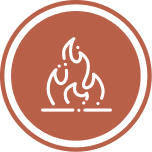 Fire (bush and grass)
Fire (bush and grass)
- The majority of Goulburn Mulwaree with the exception of central urban areas is identified as bushfire prone land. 17
- Based on potential event probability, annual average loss of residential, commercial and industrial buildings due to bushfire is estimated at 6 per cent. This accounts for low probability but high-cost consequence of bushfire activity.
- Extended periods of heat and decreasing rainfall and drought has recently seen the extension of the bushfire period. 18
- The frequency of dangerous bushfire weather days and the magnitude of bushfire weather extremes will increase in the Council area. 19
- Reduced rainfall periods will exacerbate risk of bushfire and extend bushfire period. 20
- 2019-2020 Black Summer bushfires was the worst NSW has ever recorded. With 2,448 homes were destroyed and 5.5 million hectares (ha) of land was burnt. The impact on NSW communities, farmers, local businesses, wildlife and bushland was unprecedented. 21
- Grassfires can become common on hot days and heavy winds.
Actions taken or proposed
- Bushfire prone area mapping has been developed by council and is available through the Goulburn Mulwaree Disaster Dashboard or on Council’s website.
- Council will prepare a Bushfire Management Strategy as a part of the planning for urban growth.
- Council is committed to maintain up to date bushfire prone land mapping in order.
- The NSW Government has funded a new Bushfire Tanker after the 2019/202 Black Summer bushfires, to protect the communities within the states Southern Tablelands.22
 Snow
Snow
- Snowfall forecasts during winter months are increasing, however do not pose a risk to life and property.
- Goulburn Road normally one of the first roads to require closure, Goulburn Road is considered the main arterial road to Crookwell. A good indicator of snowfalls on this road is in vicinity of the Wind Turbines and the property known as “Lake Edward”.
- Severe snowfall events may cause snowfalls and black ice to form on higher and sheltered parts of these roads. This may disrupt normal traffic movements including commuters to and from Canberra and school bus services.
Actions taken or proposed
- State Emergency Service (SES) has implemented a South Eastern Region Snow Emergency Sub Plan with key strategies and actions, in conjunction with Council.
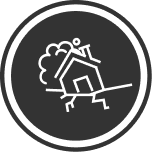 Earthquake
Earthquake
- The LGA has a low earthquake exposure and has experienced minor earthquakes in the past.
- Based on potential event probability, annual average loss of residential, commercial and industrial buildings due to earthquakes is estimated at 15 per cent. This accounts for low probability but high-cost consequence of earthquake activity.
- In May 2024, a 3.9 magnitude earthquake hit 45km from Goulburn Mulwaree. Many residents within the LGA reported that they were impacted by violent shakes.23
Actions taken or proposed
- Due to low exposure within the LGA, no actions have been taken or proposed to address earthquake risk.
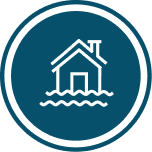 Flood (riverine and flash)
Flood (riverine and flash)
- Sections of the City of Goulburn are highly susceptible to damage and disruption from floodwaters from both the Wollondilly River and Mulwaree Chain of Ponds.24
- Based on potential event probability, annual average loss of residential, commercial and industrial buildings due to flood is estimated at 43 per cent. This accounts for low probability but high-cost consequence of flood activity.
- Historic major flood events, known to have caused flooding of properties in Goulburn, have occurred in April 1870, July 1900, June 1925, June 1950, October 1959, November 1961 and August 1974.25
- The 1961 flood event is reported to be the highest flood in recorded history on the Wollondilly River at Goulburn.26
- More recently, significant flooding in Goulburn has occurred in August 1990, December 2010, March 2012 and June 2012.27
- In 2022, Goulburn experienced extreme overland flow flooding, with the Goulburn River system peaking at one hundred and ninety times the base-flow level.28
Actions taken or proposed
- Flood prone area mapping has been developed by council and is available through the Goulburn Mulwaree Disaster Dashboard or on Council’s website.
- Goulburn Mulwaree Council and the NSW State Emergency Service (SES) have collaborated to undertake the following projects:
- Marulan Flood Study – Hydraulic and hydrologic models – complete
- Goulburn Floodplain Risk Management Study and Plan – complete
- Wollondilly and Mulwaree Rivers Flood Study – complete
- A Review of Flooding in Goulburn – complete
- Goulburn – Flood Inundation Map – complete
- Marulan Flood Study – draft.29
- Council is committed to maintain an updated Floodplain Risk Management Study and Plan for Goulburn city.
- NSW State Emergency Service (SES) prepared a Goulburn Mulwaree local flood and emergency sub plan.
- Council is currently engaged to undertake a Flood Risk Management Study that focuses on overland flow.
- Council intends to update planning provisions for flooding both within identified flood study areas and generic provisions for areas without flood studies
- Council intends to prepare a flood model for the LGA to assist and inform planning outside the urban areas.
- Council intends to identify shortfalls in infrastructure for urban drainage where affected by localised flooding.
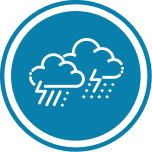 Storm and cyclone
Storm and cyclone
- Severe storms in NSW are often associated with East Coast Lows (ECL). ECL events are extreme weather systems that occur in South-East Australia, bringing extreme winds, rain, waves and elevated coastal water levels.
- Based on potential event probability, annual average loss of residential, commercial and industrial buildings due to hail is estimated at 36 per cent. This accounts for low probability but high-cost consequence of hail activity.
Note: for the purposes of this report, cyclone was not commented on.
Actions taken or proposed
- No actions have been taken or proposed for to address storm and cyclone risks within the Council area.
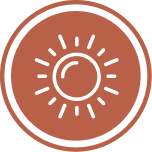 Heatwave
Heatwave
- Acute extreme temperatures can lead to health risks, particularly of aging populations, as well as higher energy costs for associated cooling. Such events can rapidly exacerbate existing drought conditions by rapidly reducing remaining surface and soil water/moisture.30
- The shocks of heatwave are typically indirect and are associated with joint probabilities of other hazards (bushfire, drought, and flood). 31
Actions taken or proposed
- Implementation of Regional Drought Resilience plan in January 2025.
 Landslide
Landslide
- The exposure in Goulburn Mulwaree is low.
- Landslide can be triggered by severe weather events (e.g. heavy rainfall) or human activities (vegetation removal, overgrazing, slope modification, etc.).
- Landslides can be caused by a major event such as earthquake, but in NSW, landslides are generally caused when heavy rain saturates soil on a hillside past the point where vegetation can support the soil’s weight against the force of gravity. The top saturated layer of soil then slips down the hill, taking whatever is on the land with it.
Actions taken or proposed
- Landslide Get Ready, deliver by the Queensland Reconstruction Authority has been referenced as a guide on the Goulburn Mulwaree Council Disaster Dashboard.
![]() Tsunami
Tsunami
- Tsunami’s can be generated by a number of causes, however, undersea earthquakes are the most likely to generate such an event. Tsunami waves can run up beyond the high tide mark causing significant damage to coastal areas.32
Actions taken or proposed
- No actions have been taken or proposed for to address storm and cyclone risks within the Council area.
Climate Change Data Summary
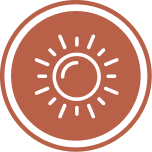
Heatwave – measured by number of days with temperatures greater than 35°C
Heatwaves are a critical climate hazard affecting health, infrastructure, and ecosystems. Heatwave risk can be measured by tracking the number of days per year with maximum temperatures exceeding 35°C. This analysis, undertaken by Risk Frontiers in 2021, drew on 20-year averages from historical climate reanalysis data and future climate model projections under a ‘medium’ emissions scenario, represented by RCP4.5 (see Figure 1 below).
(Values are 20-year averages for present day climate and change for future climate under the RCP4.5 scenario)
The data highlights how the frequency and seasonality of high-temperature events are expected to shift over time in the LGA, informing the need for climate adaptation in infrastructure, health, and planning decisions.
Key Findings:
- The frequency of hot days will increase in Goulburn Mulwaree;
- Largest increases in heatwave and high temperature extremes will be seen during the summer months; and
- High temperature extremes will also occur more frequently during spring and autumn.
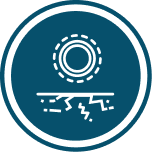
Drought – measured by Leetch-Byram measured by Keetch-Byram Drought Index, soil moisture and annual precipitation
Drought is a complex hazard influenced by temperature, rainfall, and how water is retained in the landscape. To assess how drought conditions are projected to change in the LGA, this analysis undertaken by Risk Frontiers in 2021 uses three key climate indicators:
- Keetch-Byram Drought Index (KBDI) – a widely used index that estimates how dry the landscape is based on temperature and rainfall. It also reflects the flammability of surface fuels and is commonly used for fire management (see Figure 2 below);
- Soil moisture percentiles – a direct measure of how much water is retained in the soil compared to long-term conditions. Soil moisture is essential for agriculture, vegetation health, and ecosystem resilience (see Figure 3 below);
- Total annual precipitation – tracks overall rainfall trends, which are a key input for drought but must be considered alongside evaporation and temperature to understand drought risk fully (see Figure 4 below).
(Values are 20-year averages for present day climate and change for future climate under the RCP4.5 scenario)
(Values are 20-year averages for present day climate and change for future climate under the RCP4.5 scenario)
(Values are 20-year averages for present day climate and change for future climate under the RCP4.5 scenario)
These indicators are derived from climate model simulations using 20-year averages for present-day and future scenarios under RCP4.5. Together, they provide a fuller picture of both short-term and long-term drought potential, capturing the interplay between rainfall, heat, and water retention in the landscape.
Key Findings:
- By 2070 the magnitude of drought will increase across the Council area as soil moisture declines by 2070, with the greatest impact occurring during the winter and spring
- changes in total annual rainfall are less than the projected changes in soil moisture and drought, suggesting that the increase in drought is being driven primarily by increasing temperatures and their effect on evapotranspiration.

Bush and grassfire – measured by the annual maximum Forest Fire Danger Index (FFDI)
Bushfires and grassfires are among the most dangerous and disruptive climate-related hazards in South-East NSW Region. The annual maximum Forest Fire Danger Index (FFDI) is the nationally recognised measure for assessing bushfire danger and is widely used by emergency services to guide fire warnings, restrictions, and preparedness. FFDI is a composite index that incorporates temperature, wind speed, humidity, and recent rainfall to estimate how dangerous fire weather is on a given day.
This analysis undertaken by Risk Frontiers in 2021 used 20-year averages from historical reanalysis data and future climate projections under the RCP4.5 scenario (see Figure 5 below). This indicator helps identify trends in both the severity and seasonal timing of fire weather across the LGA.
Key Findings:
(Values are 20-year averages for present day climate and change for future climate under the RCP4.5 scenario)
- The frequency of dangerous bushfire weather days and the magnitude of bushfire weather extremes will increase in the Shire.
- Average fire weather is projected to increase in summer and spring, with the number of severe fire weather days also projected to increase during these months.
- The largest changes for bushfire weather across southeast Australia are expected to be occurring during the spring, with a projected earlier onset of the bushfire season under a warmer climate.

Extreme rainfall and flooding – measured by daily precipitation over 30mm
Flooding poses a significant hazard to infrastructure, communities, and emergency services. This analysis uses the frequency of very heavy rainfall days (daily rainfall greater than 30mm) as an indicator of flood risk. This threshold (i.e., days with more than 30mm of rain often) is a recognised benchmark in climate and hydrological studies to identify rainfall events that can overwhelm stormwater systems, trigger flash flooding, and lead to significant overland flow.
Projections done by Risk Frontiers in 2021 compared 20-year averages for present day conditions with those for 2030 and 2070 under the RCP4.5 scenario. This helps to understand how the intensity of rainfall events changes, which is crucial for flood management, infrastructure design, and emergency planning (see Figure 6 below).
(Values are 20-year averages for present day climate and change for future climate under the RCP4.5 scenario)
Key findings:
- Under present day climate there are on average 4 very heavy rainfall days per year. This may change by 2070 with an expected warmer atmosphere modelled to increase high storm rainfall totals.
- The primary driver of year-to-year variability in rainfall will continue to be the tropical climate drivers of Indian Ocean Dipole (IOD), El Niño Southern Oscillation (ENSO) and the Inter-decadal Pacific Oscillation (IPO). Projections for Pacific climate are indicating an increase in ENSO amplitude, meaning both El Niño and La Niña events will be stronger.
- Extreme rainfall events will produce higher rainfall totals due to the physical relationship between a warmer temperatures and higher atmospheric moisture capacity.
- Higher rainfall totals may lead to higher flood levels during flooding events, but the frequency of these events will not differ significantly from present.

Severe storm, wind and hail – measured by East Coast Low (ECL) days and annual windspeed
Severe storms, ranging from East Coast Lows to thunderstorms and hail events, pose a recurring hazard to communities and infrastructure. This analysis uses two key indicators to evaluate storm-related risk under a changing climate:
- frequency of East Coast Low (ECL) days – ECLs are among the most damaging storm systems affecting the region, often associated with extreme winds, heavy rainfall, large waves, and coastal erosion. Tracking their frequency is important for understanding long-term storm risks (see Figure 7 below).
- annual maximum windspeed – is used to assess the strength of storm systems and frontal weather events that can bring down trees, damage infrastructure, and increase fire danger (see Figure 8 below).
(Values are 20-year averages for present day climate and change for future climate under the RCP4.5 scenario)
(Values are averaged across each LGA and calculated as 20-year averages for present day climate and change for future climate under the RCP4.5 scenario—windspeeds at individual locations and years will be significantly higher than the averages.)
These indicators help assess changes in both the occurrence and severity of damaging weather systems.
Projections done by Risk Frontiers in 2021 were based on 20-year averages comparing present-day conditions with future scenarios for 2050 and 2070 under RCP4.5. This helps identify trends in the intensity and potential impacts of storm systems in the LGA which may influence risk planning, emergency management, and infrastructure resilience.
Key Findings:
- Under present day climate, the Council area is exposed to several types of storms, including east coast lows (ECL), extra-tropical lows, fronts, snowstorms, thunderstorms, and hailstorms.
- ECL are one of the most damaging storm types to impact the Council area. ECL frequency is expected to increase slightly under future climate which is consistent with an expectation of increased large scale interactions between warm and cool air masses as the climate warms.
- Extratropical lows and associated fronts and thunderstorms can cause significant risk, especially during summertime when they are a primary cause of dangerous bushfire weather.
- Maximum annual windspeed is projected to increase across the Council area, suggesting an increase in the strength of frontal systems.
NARCLiM 2.0 Climate projections
In 2022 NARCliM 2.0 climate data was publicly released – this is the most up-to-date regional climate modelling available for NSW and ACT and is used Government planning, assessments, and strategies.
Table 2 below describes the anticipated future climate projections specific to the Goulburn LGA based on NARCLiM 2.0 RCP4.5 SSP1-2.6 (low emissions) and SSP3-7.0 (high emissions) scenarios.
This information can also be viewed through an interactive climate change projection map via https://www.climatechange.environment.nsw.gov.au/projections-map
Table 1: NARCLiM 2.0 Emission Scenario projections – Goulburn Mulwaree
Risk Exposure Summary
Risk exposure is the degree to which people, places, or assets are at risk from hazards.
The Goulburn Mulwaree Local Strategic Planning Statement33 and the South Eastern Regional Emergency Management Plan34 have identified the following 8 hazards as having risk of causing loss of life, property, utilities, services and/or the community’s ability to function within its normal capacity:
|
|
· |
In 2024, the State Disaster Mitigation Plan identifies these additional 3 hazards having the same risk to life and property:
- Coastal hazard (erosion and inundation)
- Storms and cyclones, and
- Tsunami35
The Climate modelling performed by Risk Frontiers in 2021 as part of the Resilience Blueprint found that Goulburn Mulwaree has:
- moderate/medium flood hazard risk with 21.15% of the land within a modelled floodplain. This is particularly concentrated around the main township of Goulburn being subjected to riverine flood influences (Figure 9)
- low/moderate bush and grassfire hazard risk with a modelled annual burning probability of 0.41%. This risk area is largely confined to the western boundaries of the council area (Figure 10).
A dark blue indicates a flood plain, the lighter colour out of it.
The flood hazard index uses a map of modelled flood plains identified by several geographical/geospatial variables including different river types, river stream order, distance to river network, land cover, soil type, average slopes in known flood areas, relative changes in elevation near rivers, and river basin characteristics.
Life, Property, Economic and Environmental Loss Risk
Fatalities and life loss
- Risk that is posed to life is very difficult but a reality to of natural hazards. Life loss throughout the LGA from 1900 to 30 June 2020 has been analysed using PerilAUS, Risk Frontiers’ database of natural hazard impacts.
- The analysis found that in Goulburn Mulwaree floods have resulted in the most fatalities – 15 fatalities, followed by lightning (4 fatalities), bushfire (1 fatality), gust (1 fatality) and heatwave (1 fatality).
- Despite the above, more lives have been lost as a result of the impacts of disaster events across the Council in the days, weeks, months and years that follow. The physical and mental health toll of events is enormous.
- Health issues and fatalities are not captured – data in these regards is difficult to bring together but does not change the reality of the pervasive impact of disasters.
Impact on property and infrastructure
- In terms of the risks posed to property and infrastructure, Risk Frontiers’ Natural Catastrophe loss models have been used to estimate the financial cost, or Average Annual Loss (AAL) across four key hazards in the Council area being bushfire, flood, hailstorm and earthquake. The models evaluated losses for commercial, residential and industrial properties.
- Under current conditions, the overall baseline AAL for Goulburn Mulwaree is approximately $6.7 million.
- The analysis found that riverine flood is the most significant natural hazard accounting for 57% of the AAL, followed by hail (27%).
- Future climate projections indicate that the AAL in Goulburn Mulwaree will be driven by fire and flood losses. Losses are projected to increase respectively by 22% for fire and 1% for flood by 2070 under an RCP 4.5 scenario, with a total AAL of $6.8 million.
Average Annual Loss identified in the State Disaster Mitigation Plan
Additionally, in 2024 the State Disaster Mitigation Plan (SDMP) indicates that the AAL in Goulburn Mulwaree for built environment in 2023 consisted of the following:
- Coastal hazard (erosion and inundation) – Very Low
- Storms – Low
- Cyclones – Very Low
- Tsunami – not recorded but noted as a rare event
Editors note: the SDMP does not include specific AAL per LGA. It is colour coded on a scale from $0m to $112m
Environmental Loss Risk
Risks to threatened flora, fauna and ecological communities from fire and flood were analysed using the following values:
|
|
|
The fire and flood indices were overlaid with an exposure index locating threatened flora, fauna and ecosystems along with agricultural lands. The analysis found that there are:
- Fauna exposure is medium/high. There are 29 different vulnerable animal species in the Council area, of which 16 are vulnerable, 7 are endangered, and 6 are critically endangered.
- Flora exposure is high. There are 29 different vulnerable plant species in the Council area, of which 15 are vulnerable, 11 are endangered and 6 are critically endangered.
- Ecological community exposure is high/extremely high. There are 3 different vulnerable ecological communities in the Council area, all of which are critically endangered.
The analysis also indicated that the natural environment encompasses 40.64% of the Council area (33.34% of which is protected), 34.34% devoted to agriculture and farming and the remaining 24.92% is developed built environment.
The total maximum above ground biomass (indicating the potential vegetation density the LGA could support) is low at 1,110 tonnes of dry matter over the LGA.
Overall, Goulburn Mulwaree’s environment has medium exposure with patches of exposure that is high as seen in Figure 13.
Figure13: Goulburn Mulwaree Overall Exposure Index–Risk Frontier 2021
Risk to Agricultural Productivity
Figure 14: Distribution of the Average Annual Loss (AAL) of infrastructure by hazard for Goulburn Mulwaree – Risk Frontiers 2021
- A projected decrease in soil moisture from a warming climate may impact sheep productivity, while increased frequency of hot days could impact sheep productivity; and beef when compared to consecutive dry and hot days in Goulburn Mulwaree.
- There is a correlation between agricultural productivity and climate parameters representing temperature and hydroclimate variability. Productivity of beef and sheep operations tends to be higher during years that are wetter and cooler with retained soil moisture, and low risk of drought (see Figure 14 above).
Vulnerability and Capacity
Resilience is generally regarded as a function of the intersection of relative exposure, social vulnerability and community capacity:
- Relative exposure is a function of hazard, describing the frequency and magnitude of natural hazard events and capturing the compounding effect of multiple hazards (fire and flood for this analysis).
- Physical exposure of a community is determined such that the quantum of exposed people, buildings, essential facilities, industry, and agriculture can be evaluated.
- Social vulnerability is determined by examining socio-economic and demographic factors that may exacerbate or ameliorate the effects of an external threat to a person’s life, livelihood, or assets.
- Community capacity to resist, avoid and / or adapt to a disaster and to use these abilities to create security either before or after a disaster can be determined by examining several factors.
For each of these measurement framework indicators, an index has been produced by a weighted average of each metric contributing to the category. An analysis of the measurement framework indicators for each Statistical Area 1 (SA1) across South East NSW culminates as an integrated index of resilience; Figure 15 and Figure 16 shows community resilience indices for Goulburn Mulwaree.
- In Goulburn Mulwaree, the mean relative exposure component of the resilience index is average for bush/grass fire and high/extremely high for flood.
- There are no SA1s scoring low or extremely low for either resilience to bush/grassfire or flood, as well as relatively exposure component of resilience to either bush/grass fire and flood.
- The Council area’s mean social vulnerability score is low average. 42.8% of the population reside in SA1s scoring low or worse for the social vulnerability component of resilience.
- The mean community capacity component for both bush/grass fire and flood is average. 2.2% of the population reside in SA1s scoring low or worse for the community capacity component of resilience to flood and 12% score low or worse for the community capacity component of resilience to bush/grass fire.
Gaps in Data
While this Goulburn Mulwaree Local Profile is underpinned by robust regional data and hazard modelling, several key data gaps remain that limit the precision of localised risk reduction planning:
- Community preparedness and capacity indicators: No recent community survey data exists on disaster readiness, access to emergency plans, or levels of volunteering in disaster response organisations.
- Historical event records: Detailed local records on the frequency, impacts, and recovery costs of past snow, storm, hail, and earthquake events are limited or not centralised.
- Economic disruption data: There is insufficient insight into how previous disasters have impacted the local economy, particularly small businesses, tourism, and agricultural supply chains.
- Infrastructure interdependencies: Modelling on critical infrastructure interdependencies (e.g., how flood risk to roads affects emergency access or supply deliveries) is not available at the LGA level.
- Monitoring and evaluation systems: Goulburn currently lacks a framework to consistently track resilience outcomes over time, including climate impact monitoring and post-disaster recovery effectiveness.
Reference
- Goulburn Mulwaree Council, 2020, Local Strategic Planning Statement. Available online at https://www.goulburn.nsw.gov.au/Development/Plans-Strategies#section-2
- idcommunity, 2024, Goulburn Walwaree Council Community Profile. Available at profile.id.com.au/goulburn
- idcommunity, 2022, Goulburn Walwaree Council Community Profile. Available at https://profile.id.com.au/goulburn/population
- idcommunity, 2021, Goulburn Walwaree Council area: Agriculture Economy.id Goulburn Mulwaree Agriculture
- idcommunity, 2021, Goulburn Walwaree Council area: Employment by industry. Available at https://economy.id.com.au/goulburn/employment-by-industry
- idcommunity, 2021, Goulburn Mulwaree Council area: Worker productivity. Available at https://economy.id.com.au/goulburn/worker-productivity-by-industry
- idcommunity, 2021, Goulburn Mulwaree Council area: Gross Regional Product. Available at https://economy.id.com.au/goulburn/gross-regional-product
- Goulburn Mulwaree Council, 2007, Goulburn Mulwaree Council Biodiversity Strategy. Available at https://www.goulburn.nsw.gov.au/Development/Plans-Strategies#section-11
- Goulburn Mulwaree Council, 2022, Goulburn Mulwaree Local Strategic Planning Statement. Available at https://www.goulburn.nsw.gov.au/Development/Plans-Strategies#section-2
- Goulburn Mulwaree Council, 2016, Goulburn Mulwaree Employment Lands Strategy 2016. Available at https://www.goulburn.nsw.gov.au/files/sharedassets/public/other-files/employment-land-strategy.pdf
- idcommunity, 2024, Goulburn Mulwaree Council Community Profile. Available at profile.id.com.au/goulburn
- idcommunity, 2024, Goulburn Mulwaree Council Community Profile. Available at profile.id.com.au/goulburn
- Goulburn Mulwaree Council, 2022, Goulburn Mulwaree Local Strategic Planning Statement. Available at https://www.goulburn.nsw.gov.au/Development/Plans-Strategies#section-2
- Australian Bureau of Statistics, 2021, Goulburn Mulwaree. Available at https://abs.gov.au/census/find-census-data/quickstats/2021/LGA13310
- Goulburn Mulwaree Council, 2022, Goulburn Mulwaree Local Strategic Planning Statement. Available at https://www.goulburn.nsw.gov.au/Development/Plans-Strategies#section-2
- Goulburn Mulwaree Council, 2025, The role of the Mayor and Councillors. Available at https://www.goulburn.nsw.gov.au/Council/Contact-a-Councillor#section-2
- Goulburn Mulwaree Council, 2020, Local Strategic Planning Statement, available online at https://www.goulburn.nsw.gov.au/Development/Plans-Strategies#section-2
- Goulburn Mulwaree Council, 2020, Local Strategic Planning Statement, available online at https://www.goulburn.nsw.gov.au/Development/Plans-Strategies#section-2
- Ibid
- Ibid
- ADRI https://knowledge.aidr.org.au/resources/black-summer-bushfires-nsw-2019-20/
- NSW Government Fire and Rescue, 2024, Latest Bushfire Tanker headed to Southern Tablelands – Goulburn. Available at https://www.fire.nsw.gov.au/incident.php?record=reco41xLychwJqP4j#:~:text=A%20new%2C%20state%2Dof%2D,2019%2F20%20Black%20Summer%20bushfires.
- The Sydney Morning Herald, 2024, ‘Like a truck hitting the house’: 3.9-magnitude earthquake hits Goulburn. Available online at: https://www.smh.com.au/national/nsw/like-a-truck-hitting-the-house-3-9-magnitude-earthquake-hits-goulburn-20240523-p5jfwr.html
- NSW State Emergency Service NSW Flood data Portal, 2025, Wollondilly River and Mulwaree Chain of Ponds – Floodplain Risk Management Study and Plan. Available at https://flooddata.ses.nsw.gov.au/flood-projects/wollondilly-river-mulwaree-chain-of-ponds-floodplain-risk-management-study-plan#:~:text=Sections%20of%20the%20City%20of,the%20Wollondilly%20River%20at%20Goulburn.
- Goulburn Mulwaree Council, 2020, Local Strategic Planning Statement, available online at https://www.goulburn.nsw.gov.au/Development/Plans-Strategies#section-2
- NSW State Emergency Service NSW Flood data Portal, 2025, Wollondilly River and Mulwaree Chain of Ponds – Floodplain Risk Management Study and Plan. Available at https://flooddata.ses.nsw.gov.au/flood-projects/wollondilly-river-mulwaree-chain-of-ponds-floodplain-risk-management-study-plan#:~:text=Sections%20of%20the%20City%20of,the%20Wollondilly%20River%20at%20Goulburn.
- Goulburn Mulwaree Council, 2020, Local Strategic Planning Statement, available online at https://www.goulburn.nsw.gov.au/Development/Plans-Strategies#section-2
- Goulburn Murray Water, 2023, Floods in Focus: Goulburn River system, available online at https://www.g-mwater.com.au/customer-services-resources/flood-advice/floods-in-focus-goulburn-river-system
- NSW State Emergency Service, 2025, NSW Flood Data Portal. Available at https://flooddata.ses.nsw.gov.au/organization/goulburn-mulwaree-council
- Department of Agriculture, Fisheries and Forestry, 2024, Goulburn Mulwaree Council and Wingecarribee Shire Council Regional Drought Resilience Plan. Available at https://www.agriculture.gov.au/sites/default/files/documents/goulburn-mulwaree-and-wingecarribee-rdr-plan.pdf
- Ibid
- NSW State Emergency Service, 2023, New South Wales State Tsunami Plan. Available online at https://www.nsw.gov.au/sites/default/files/noindex/2024-02/2023_NSW_State_Tsunami_Plan.pdf
- Goulburn Mulwaree Council, 2020, Local Strategic Planning Statement, available online at https://www.goulburn.nsw.gov.au/Development/Plans-Strategies#section-2
- South Eastern Regional Emergency Management Committee, 2023, South Eastern Regional Emergency Management Plan March 2021 (updated October 2023). Available online at https://www.nsw.gov.au/rescue-and-emergency-management/regions/southern-eastern
- NSW Reconstruction Authority, 2024, State Disaster Mitigation Plan 2024-2026. Available online https://www.nsw.gov.au/sites/default/files/noindex/2024-02/State_Disaster_Mitigation_Plan_Full_Version_0.pdf




























